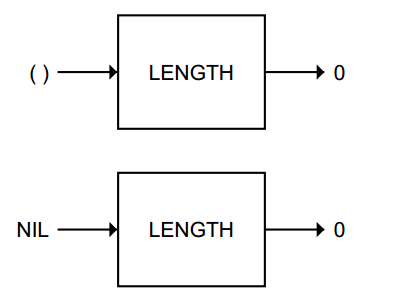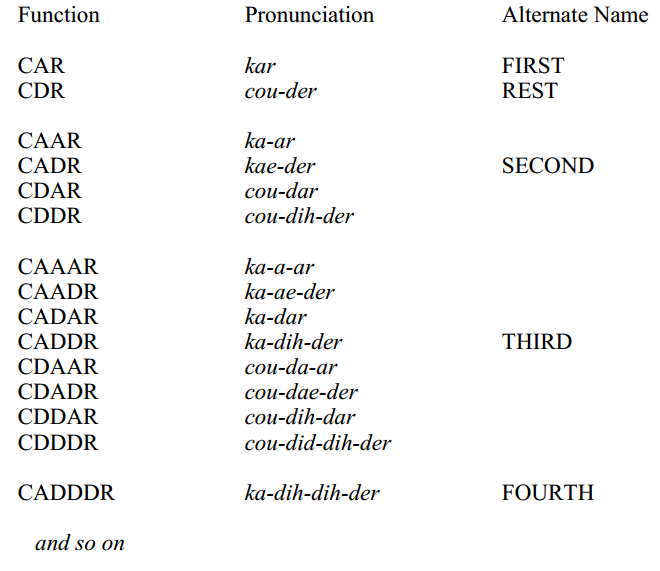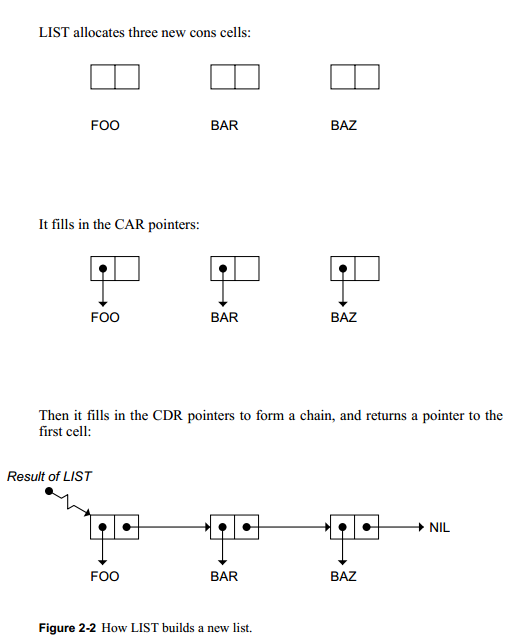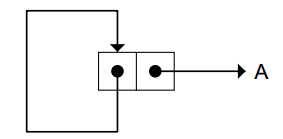list
Listsare importantbecause they can be made to represent practically anything: sets, tables, and graphs, and even English sentences.
Functionscan also be represented as lists
Every list has two forms: a printed representation and an internalone. --API & reality in memory
((BLUE SKY)
(GREEN GRASS)
(BROWN EARTH))

LENGTH
NIL and the empty list are identical, (A NIL B)can
also be written (A( ) B)

FIRST,SECOND, THIRD, AND REST(return list except first)
C...R
CAR CDR
Besides naming the two halves of a cons cell, CAR and CDR are also the names of built-in Lisp functions that return whatever pointer isin the CAR or CDR half of the cell, respectively.
reverse order CADR = INPUT-->CDR-->CAR

CONS
The CONS function creates cons cells.Ittakes two inputs and returns a pointer to a new cons cell whose CAR points to the first input and whose CDR points to the second.
it returns a pointer to the new cell
 To really understandwhat CONS does, it is better to think about it using
cons cell notation.
To really understandwhat CONS does, it is better to think about it using
cons cell notation.
second input better be a list,or seems wired cause output is not a list(for right point to a non-cons cell)

x = CONS of (CAR of x) and (CDR of x) when x is not NIL
LIST
mutiple inputs


LISTP & CONSP &ATOM
CONSP is almost the same as LISTP; the difference is in their treatment of NIL. NIL is a list, but it is not a cons cell.(no memory block)
ATOM and CONSP are opposites
NULL
The NULL predicate returnsT if its input is NIL
dotted list
(A B C . D)

circular list
‘‘sharp-equal notation,’’
We will use integers for labels, and the notation #n= to label an object
\#1=(A B C . #1#)

\#1=(#1# . A)

The LENGTH of a listis the number of top-level cons cells in the chain. Therefore the length of (A B C . D) is 3, not 4.
SUMMARY
The important points about CAR and CDR are:
- CAR and CDR accept only lists as input.
- FIRST and REST are the same as CAR and CDR.
- SECOND and THIRD are the same as CADR and CADDR.
- Common Lisp provides built-in C...R functions for all combinations of CAR and CDR up to andincluding four As and Ds.
The symbol NIL has several interesting properties:
- NIL is a symbol. It is the only way to say ‘‘no’’ or ‘‘false’’ in Lisp.
- NIL is a list. It is the empty list; its LENGTH is zero.
- NIL is the only Lisp object that is both a symbol and a list.
- NIL marks the end of a cons cell chain. When lists are printed in parenthesis notation, the NILs at the end of chains areomitted by convention.
- NIL and () are interchangeable notations for the same object.
- The CAR and CDR of NIL are defined to be NIL.